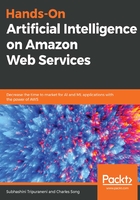
What is AI?
AI is an umbrella term that describes a branch of computer science that aims to create intelligent agents. The field of AI is highly technical and specialized; there is a broad set of theories, methods, and technologies in AI that allow computers to see (computer vision), to hear (speech recognition), to understand (natural language processing), to speak (text-to-speech), and to think (knowledge reasoning and planning).
It may seem that AI is a buzzword of our current times, but it has existed since the 1950s, when early work on artificial neural networks that mimic led the human brain stirred up excitement for thinking machines. With all the fanfare it receives in the media today, it is hard to believe that this field had to endure two AI winters, where interest in AI research and development dwindled. Today, AI has become popular again, thanks to the increased volume of data, cheaper storage, advancements in algorithms, and an increase in computing power.
One of the most important subfields of AI is machine learning (ML). ML is such a prominent part of AI that these two terms are often used interchangeably today. ML is the most promising set of techniques to achieve AI. These techniques gave us a new way to program computers through self-learning algorithms that can derive knowledge from data. We can train ML models that can look for patterns and draw conclusions like humans would. With these self-learning algorithms, the data itself has become the most valuable asset. Data has become the competitive advantage in industries; it is the new intellectual property. Between similar ML techniques (even inferior ML techniques), the best data will win.
What's old is new again. Artificial neural networks, once again, became the focus for ML research and development. More data, more compute, and new algorithms such as backpropagation, are enabling neural networks to have many hidden layers, also known as deep neural networks or deep learning. The increase in the accuracy of deep neural network models was almost impossible just a few years ago. Today, deep learning is the major breakthrough that is driving the modern-day AI boom. This combination of data, software, and hardware is creating a new breed of intelligent agents that can often see, hear, understand, speak, and even think like humans when provided with abundant information that is related to the world.
AI has become a vital part of the technology landscape. Businesses, big and small, are solving problems by leveraging AI. AI capabilities are seeping into every aspect of our lives, giving us better memory, better vision, better cognitive abilities, and much more. In most cases, AI will not be sold as the product by itself. Rather, products you already use will be improved with AI, and will become intelligent-enabled solutions. What is most exciting to us is the democratization of AI and ML technologies and services. The abundance of such technologies and services means practitioners can easily leverage AI to add intelligence to products that affects the way we live, work, and play.
This book will help you become an AI practitioner. We will teach you, through hands-on projects, the tools and techniques that are needed to embed AI capabilities into software solutions. Successful intelligent-enabled solutions require a combination of architecture design, software engineering, and data science. You will learn how to design, develop, deploy, and maintain production-grade software solutions with AI capabilities. As an AI practitioner, it is important to see AI through the lens of business capabilities, rather than just technologies. This book aims to bring together various skills to help you develop an intuition for well-designed intelligent-enabled solutions that solve real-world problems.